Bertha Barnes
Return to Ships of John Gregory
|
Bertha Barnes US No. 2935
|
||||||||
|
Year
Built |
Last
Year |
Built At
|
Type
|
Length
|
Beam
|
Draft
|
Gross
Tons |
Net
Tons |
|
1872
|
1920
|
Sheboygan, WI
|
Schooner
|
151.5
|
30.0
|
10.4
|
330.91
|
272.00
|
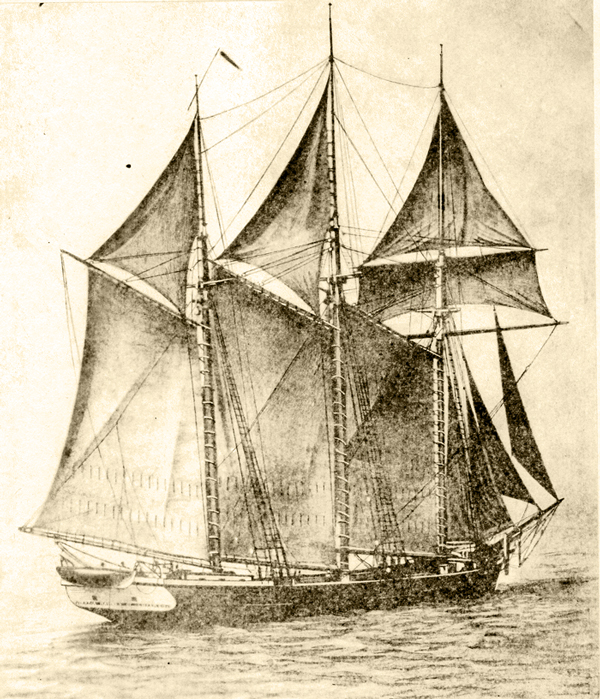
In Sheboygan, WI, the firm of Thayer & Gregory launched the Bertha Barnes (US No. 2935) schooner on the Saturday afternoon of 27 July 1872. She was owned by Nathan Ludington & Co. and Capt. J. Sargison, who superintended. The inspector pronounced her frames the best he has seen put into a vessel. She was to ply between Sheboygan and Menominee in the lumber trade, and would be ready for business in two to three weeks.
She had three masts and was over 151 feet long, weighed 330 gross tons and usually had a crew of 6 with her. She was outfitted with steam boilers to hoist the sails. The schooner can hold 420,000 ft of lumber or 600 tons.
While heading from Chicago to Marinette, the Bertha Barnes was caught in a gale and grounded her near the Wind Point Lighthouse in April 1893.
Capt. J. C. Clark, of the schooner Bertha Barnes, arrived at North Tonawanda on on 11 July 1904 with a load of lumber had experienced some trouble with his crew over their pay, spent the night at a local hotel, fearing for his life if he slept on the boat. He claimed that the crew threatened his life the day before. He then secured a policeman the next morning and went aboard. His trunk was broken into and $10 in money and other valuables were stolen. The cook stated that she heard someone in the cabin during the night, but thought it was the captain. The crew claimed that they had pay for 24 days due, while the captain asserted was for 22 days only. One of the crew accepted his pay in accordance with the captain’s views, but the other sailors decided, after consultation with Secretary Lester of the Local Seaman’s Union to secure a United States Marshall and tie the Bertha Barnes up until they have been paid for 24 days work.
The schooner Bertha Barnes ran on the lower end of Fighting Island, near Detroit yesterday and was later released by the tug Home Rule. – Buffalo Evening News, July 9, 1904
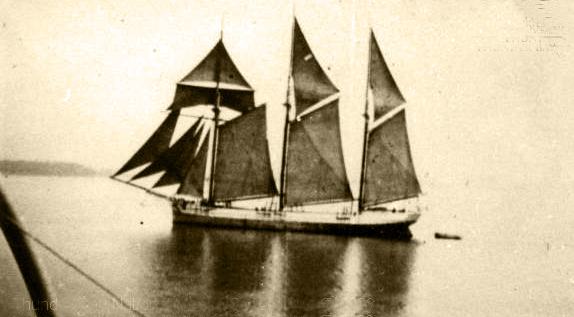
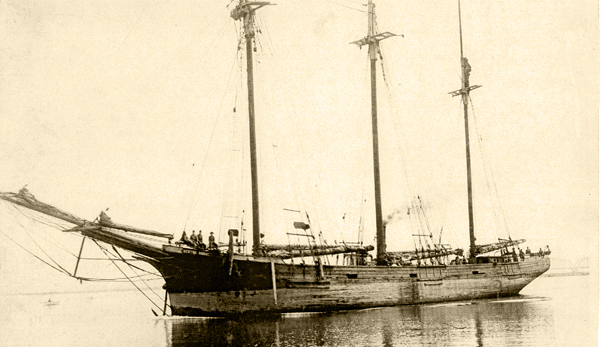
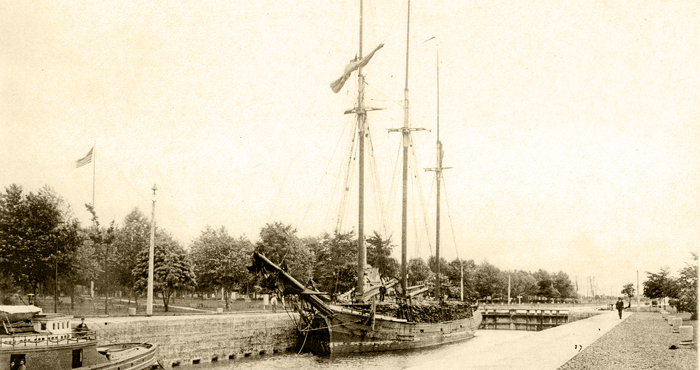
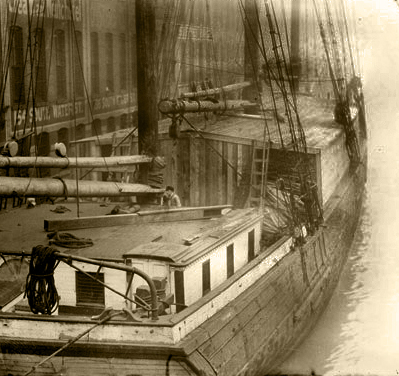 |
Information on the early years of the Bertha Barnes is still being researched, but she was one of several vessels that Captain Herman E. Schuenemann used for his famous annual Christmas Tree runs. Every year from 1886 to the fateful last in 1912 Captain Schuenemann made the dangerous late November run from the Upper Peninsula to Chicago in order to sell Christmas trees along a Chicago River dock. In 1903 the ship had a tonnage change.
In 1909 Captain Schuenemann chartered the Bertha Barnes for this season’s run. He was using the Wrenn, but the ship nearly chucked the captain and his crew into Davy Jones’ Locker. The photo on the right was taken after she arrived (citation below). The newspaper Chicago Inter Ocean on 7 December 1909 published the following article:
SCENES ABOARD THE BERTHA BARNES, THE CHRISTMAS TREE BOAT.
“Christmas trees are going to be high this year,” observed Captain Schuenemann as he stood on the bridge of the schooner Bertha Barnes yesterday and filled the bowl of his pipe with tobacco that he had been rolling in the palm of his hand. “It is about the slimmest cargo I ever brought away. Why, I’ve only got about 15,000 trees on the whole ship, and you know, of course, the Chicago market depends pretty much on my supply. It’s the bad weather that’s to blame. Say, I’m wondering if our poor luck in getting trees this year hasn’t something to do with our changing boats. We’re on the Bertha Barnes this year. It’s the first time she ever had this honor and she acts as if she’s mighty proud of it. But I can’t help feeling a mite sorry for the (George L.) Wrenn (US No. 10816).” The captain beamed his broadest smile as half a hundred girls and women came out of the cabin where they had been twining and weaving wreaths. “Hooray for Captain Schuenemann!” shouted some of the women as they waved their handkerchiefs at the jolly old skipper who resembles Santa Claus.
The following season, Capt. Schuenemann bought 1/8 interest in the ship Rousse Simmons (US No. 110087). The popular captain and his crew perished in a storm on the Rousse Simmons during the 1912 run.
On 24 June 1911 the boat was rebuilt and renamed W. D. Hossack at Milwaukee, WI. After the 1912 fateful storm that sunk the Rousse Simmons, other schooners were arriving into the Chicago port crusted with ice, These included the George A. Marsh (US No. 85727) and W. D. Hossack on December 8th, while the schooners Minerva (US No. 16628) and Arizona (US No. 1414) arrived the day before. The Edward E. Skeele US No. 19674), J. V. Taylor (US No. 13874) and Cora A. (US No. 126566) arrived in Chicago on 9 December 1912.
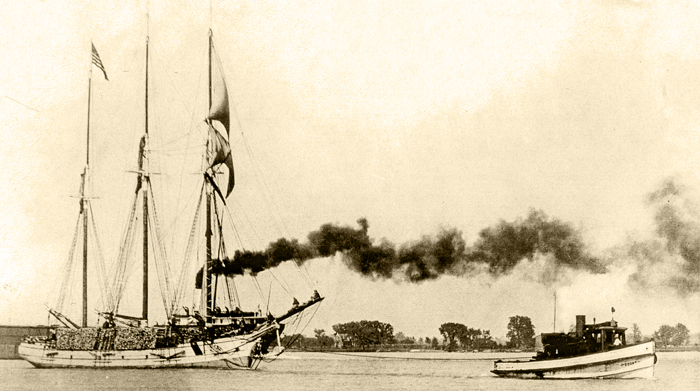
Winand Schlosser of Milwaukee, Wisconsin sold the W. D. Hossack on 1 June 1916 to Mobile and Bermuda S. S. Company. The schooner was used in the lumber trade out of Mobile, Alabama and later to Pensacola, Florida.
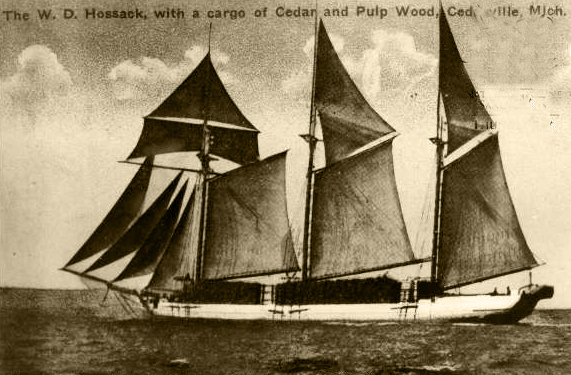
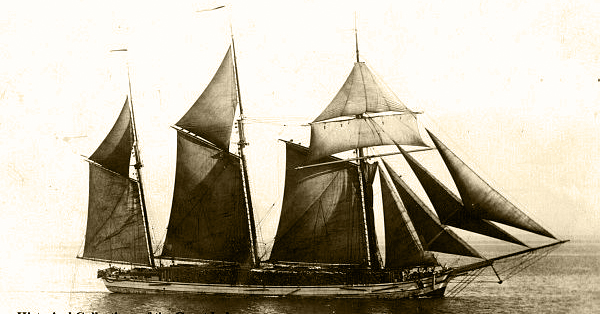
On 4 August 1920, she foundered off the Isla de Pinos (Isle of Pines), which was renamed Isla de la Juventud (Isle of Youth) in 1978, located just south of Cuba. There were nine aboard at the time, but no lives were lost.
About 200 shipwrecks have been reported in the Archipiélago de los Canarreos which is comprised of about 350 isles and form the municipality of Isla de la Juventud.
1909 Bertha Barnes photo (DN-0055443), Chicago Daily News negatives collection, Chicago Historical Society



